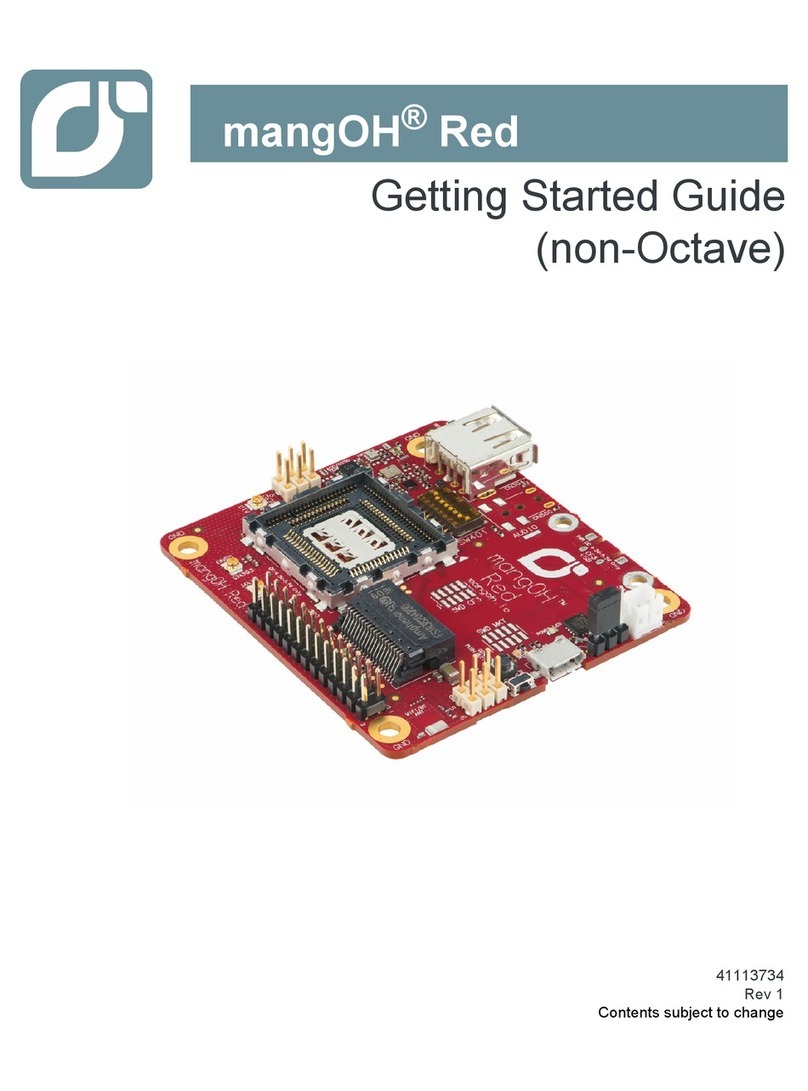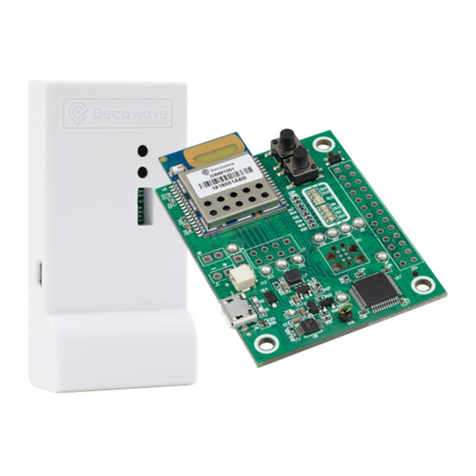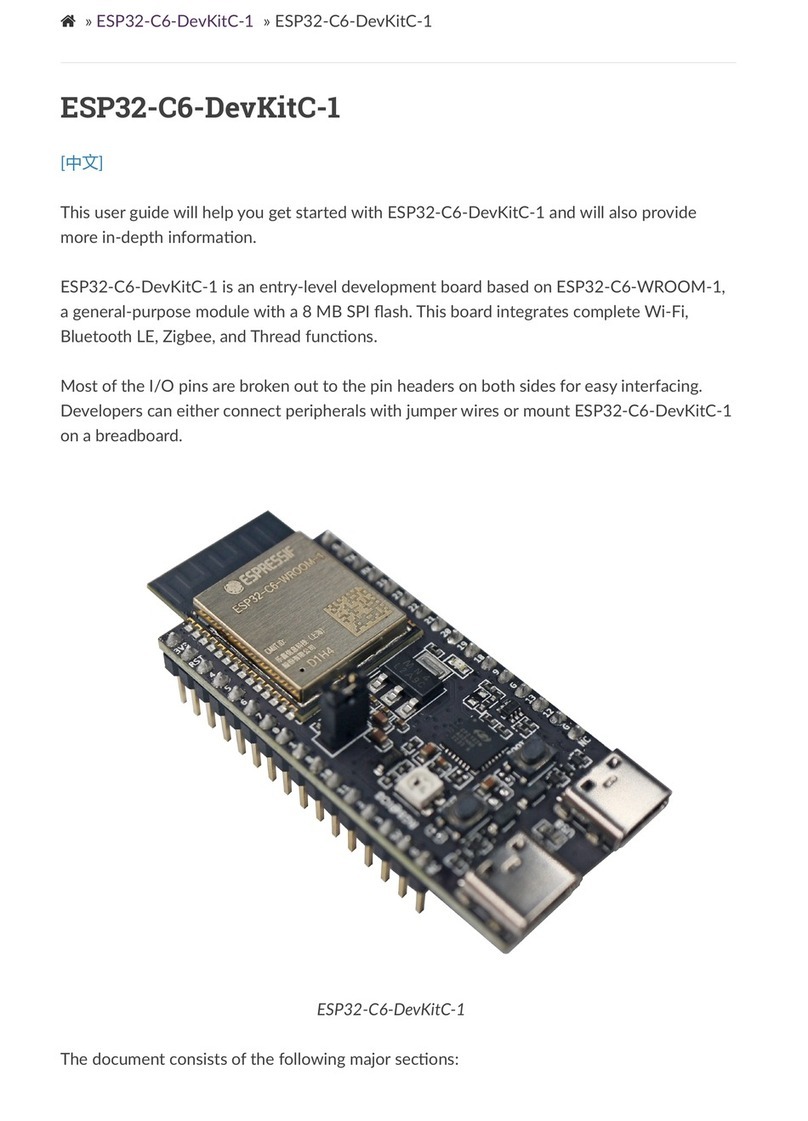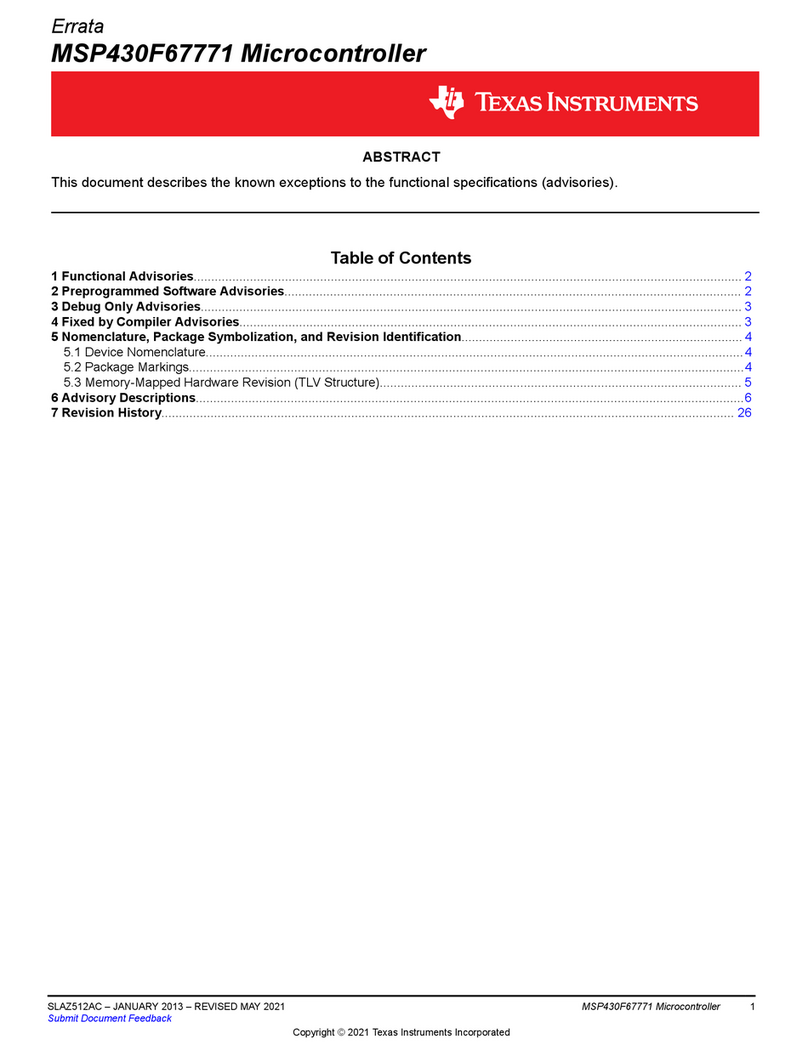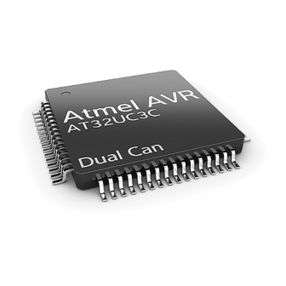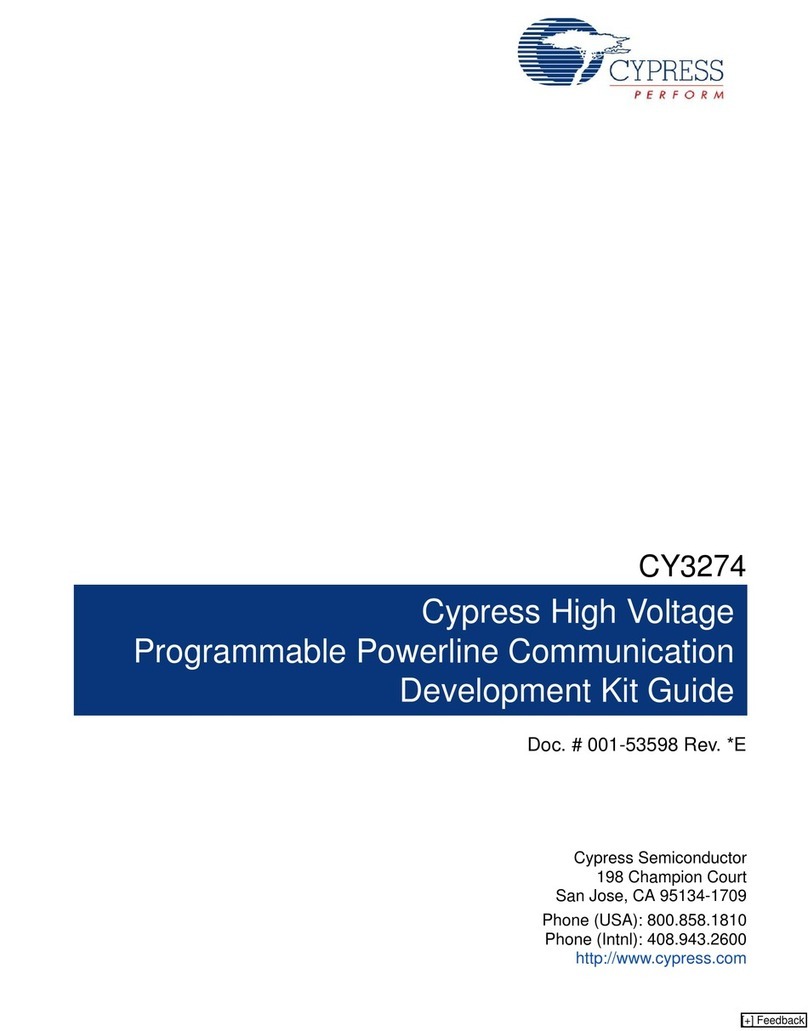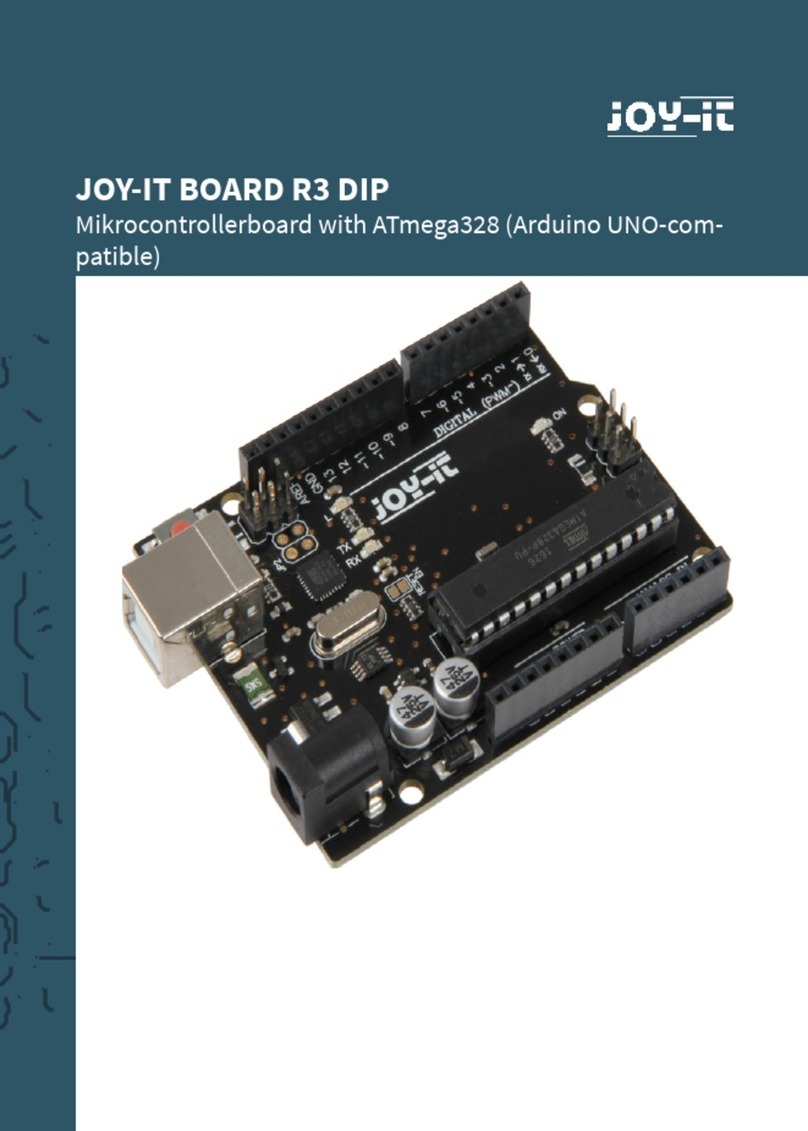mangOH Green DV4 Instruction Manual

mangOH™ Green (DV4)
Developer’s Guide
4118903
Rev 2

mangOH Green (DV4) Developer’s Guide
Rev 2 Jun.16 2 4118903
Important
Notice Due to the nature of wireless communications, transmission and reception of data can
never be guaranteed. Data may be delayed, corrupted (i.e., have errors) or be totally
lost. Although significant delays or losses of data are rare when wireless devices such
as the Sierra Wireless modem are used in a normal manner with a well-constructed
network, the Sierra Wireless modem should not be used in situations where failure to
transmit or receive data could result in damage of any kind to the user or any other
party, including but not limited to personal injury, death, or loss of property. Sierra
Wireless accepts no responsibility for damages of any kind resulting from delays or
errors in data transmitted or received using the Sierra Wireless modem, or for failure
of the Sierra Wireless modem to transmit or receive such data.
Safety and
Hazards Do not operate the Sierra Wireless modem in areas where blasting is in progress,
where explosive atmospheres may be present, near medical equipment, near life
support equipment, or any equipment which may be susceptible to any form of radio
interference. In such areas, the Sierra Wireless modem MUST BE POWERED OFF.
The Sierra Wireless modem can transmit signals that could interfere with this
equipment.
Do not operate the Sierra Wireless modem in any aircraft, whether the aircraft is on
the ground or in flight. In aircraft, the Sierra Wireless modem MUST BE POWERED
OFF. When operating, the Sierra Wireless modem can transmit signals that could
interfere with various onboard systems.
Note: Some airlines may permit the use of cellular phones while the aircraft is on the ground
and the door is open. Sierra Wireless modems may be used at this time.
The driver or operator of any vehicle should not operate the Sierra Wireless modem
while in control of a vehicle. Doing so will detract from the driver or operator's control
and operation of that vehicle. In some states and provinces, operating such
communications devices while in control of a vehicle is an offence.
Limitation of
Liability The information in this manual is subject to change without notice and does not
represent a commitment on the part of Sierra Wireless. SIERRA WIRELESS AND ITS
AFFILIATES SPECIFICALLY DISCLAIM LIABILITY FOR ANY AND ALL DIRECT,
INDIRECT, SPECIAL, GENERAL, INCIDENTAL, CONSEQUENTIAL, PUNITIVE OR
EXEMPLARY DAMAGES INCLUDING, BUT NOT LIMITED TO, LOSS OF PROFITS
OR REVENUE OR ANTICIPATED PROFITS OR REVENUE ARISING OUT OF THE
USE OR INABILITY TO USE ANY SIERRA WIRELESS PRODUCT, EVEN IF
SIERRA WIRELESS AND/OR ITS AFFILIATES HAS BEEN ADVISED OF THE
POSSIBILITY OF SUCH DAMAGES OR THEY ARE FORESEEABLE OR FOR
CLAIMS BY ANY THIRD PARTY.
Notwithstanding the foregoing, in no event shall Sierra Wireless and/or its affiliates
aggregate liability arising under or in connection with the Sierra Wireless product,
regardless of the number of events, occurrences, or claims giving rise to liability, be in
excess of the price paid by the purchaser for the Sierra Wireless product.

Preface
Rev 2 Jun.16 3 4118903
Patents This document contains information which is proprietary to Sierra Wireless Inc. and is
licensed pursuant to Creative Commons Attribution 4.0 International License.
Document
details Title: mangOH Green User Guide
Author: Sierra Wireless
Source: http://mangoh.io/
Copyright © 2016 Sierra Wireless. Licensed under the Creative Commons Attribution 4.0
license, http://creativecommons.org/licenses/by/4.0/
Disclaimer Indicate any modifications made to the original document.
Trademarks mangOH™ and the mangOH logo are trademarks of Sierra Wireless.
Other trademarks are the property of their respective owners.
Revision
History
Revision
number Release date Changes
1March 2016 Document created based on DV3 document
2June 2016 Replaced ‘IOT Connector’ references with ‘IOT Expansion Card’

Rev 2 Jun.16 4 4118903
Contents
Introduction . . . . . . . . . . . . . . . . . . . . . . . . . . . . . . . . . . . . . . . . . . . . . . . . . . . . . . . . . . . . . . . 5
Hardware . . . . . . . . . . . . . . . . . . . . . . . . . . . . . . . . . . . . . . . . . . . . . . . . . . . . . . . . . . . . . . . . . 6
mangOH Green Hardware Overview. . . . . . . . . . . . . . . . . . . . . . . . . . . . . . . . . . . . . . . . . . 6
mangOH Green Hardware Architecture. . . . . . . . . . . . . . . . . . . . . . . . . . . . . . . . . . . . . . . . 9
mangOH Green Hardware Components . . . . . . . . . . . . . . . . . . . . . . . . . . . . . . . . . . . .10
MUXing . . . . . . . . . . . . . . . . . . . . . . . . . . . . . . . . . . . . . . . . . . . . . . . . . . . . . . . . . . . . . . . 16
Primary CF3 Module Signals. . . . . . . . . . . . . . . . . . . . . . . . . . . . . . . . . . . . . . . . . . . . . . . 17
ADC . . . . . . . . . . . . . . . . . . . . . . . . . . . . . . . . . . . . . . . . . . . . . . . . . . . . . . . . . . . . . . . .17
Audio (Analog and PCM) . . . . . . . . . . . . . . . . . . . . . . . . . . . . . . . . . . . . . . . . . . . . . . . .18
Primary CF3 GPIOs . . . . . . . . . . . . . . . . . . . . . . . . . . . . . . . . . . . . . . . . . . . . . . . . . . . .18
GPIO Expanders . . . . . . . . . . . . . . . . . . . . . . . . . . . . . . . . . . . . . . . . . . . . . . . . . . . . . .20
HSIC (USB/Ethernet) . . . . . . . . . . . . . . . . . . . . . . . . . . . . . . . . . . . . . . . . . . . . . . . . . .22
I2C1 . . . . . . . . . . . . . . . . . . . . . . . . . . . . . . . . . . . . . . . . . . . . . . . . . . . . . . . . . . . . . . . .23
RF . . . . . . . . . . . . . . . . . . . . . . . . . . . . . . . . . . . . . . . . . . . . . . . . . . . . . . . . . . . . . . . . .24
SDIO . . . . . . . . . . . . . . . . . . . . . . . . . . . . . . . . . . . . . . . . . . . . . . . . . . . . . . . . . . . . . . .24
SPI1 . . . . . . . . . . . . . . . . . . . . . . . . . . . . . . . . . . . . . . . . . . . . . . . . . . . . . . . . . . . . . . . .25
SPI2 . . . . . . . . . . . . . . . . . . . . . . . . . . . . . . . . . . . . . . . . . . . . . . . . . . . . . . . . . . . . . . . .26
UART1 . . . . . . . . . . . . . . . . . . . . . . . . . . . . . . . . . . . . . . . . . . . . . . . . . . . . . . . . . . . . . .26
UART2 . . . . . . . . . . . . . . . . . . . . . . . . . . . . . . . . . . . . . . . . . . . . . . . . . . . . . . . . . . . . . .27
UIM Signals . . . . . . . . . . . . . . . . . . . . . . . . . . . . . . . . . . . . . . . . . . . . . . . . . . . . . . . . . .28
USB 2.0 . . . . . . . . . . . . . . . . . . . . . . . . . . . . . . . . . . . . . . . . . . . . . . . . . . . . . . . . . . . . .29
Secondary CF3 Module Signals . . . . . . . . . . . . . . . . . . . . . . . . . . . . . . . . . . . . . . . . . . . . 30
RF . . . . . . . . . . . . . . . . . . . . . . . . . . . . . . . . . . . . . . . . . . . . . . . . . . . . . . . . . . . . . . . . .30
UIM2 . . . . . . . . . . . . . . . . . . . . . . . . . . . . . . . . . . . . . . . . . . . . . . . . . . . . . . . . . . . . . . .30
USB 2.0 . . . . . . . . . . . . . . . . . . . . . . . . . . . . . . . . . . . . . . . . . . . . . . . . . . . . . . . . . . . . .30
IoT Connector Interfaces . . . . . . . . . . . . . . . . . . . . . . . . . . . . . . . . . . . . . . . . . . . . . . . . . . 31
Arduino-compatible Circuit Signals . . . . . . . . . . . . . . . . . . . . . . . . . . . . . . . . . . . . . . . . . . 32
Reset Methods. . . . . . . . . . . . . . . . . . . . . . . . . . . . . . . . . . . . . . . . . . . . . . . . . . . . . . . . . . 33
Power Management. . . . . . . . . . . . . . . . . . . . . . . . . . . . . . . . . . . . . . . . . . . . . . . . . . . . . . 34

Rev 2 Jun.16 5 4118903
1
1: Introduction
The mangOH Green is an open-source hardware development platform for CF3
modules that incorporates several hardware interfaces and standardized IoT
Expansion Card slots for expanded functionality.
The purpose of this developer’s guide is to describe the mangOH Green’s architecture
and provide details on how to develop applications for CF3 modules.
Important: This version of the Developer’s Guide applies to mangOH Green DV4. The guide
for mangOH Green DV3 is available at mangoh.io.
The standard mangOH Green documentation suite, available at mangoh.io, includes:
•mangOH Green Getting Started Guide
•mangOH Green User Guide
•mangOH Green Developer’s Guide (This document)
•mangOH Green AirVantage Developer’s Guide (forthcoming)
•Project mangOH IoT Expansion Card Design Specification
•Product Specifications for Sierra Wireless IoT Expansion Cards (forthcoming)

Rev 2 Jun.16 6 4118903
2
2: Hardware
This chapter describes the mangOH Green platform’s hardware components and
interfaces.
mangOH Green Hardware Overview
Figure 2-1 provides an overview of the mangOH Green’s hardware components
relative to the primary CF3 module, and Figure 2-2 on page 7 and Figure 2-3 on
page 8 show their locations.
For additional details, see the following documents available at mangoh.io.
•Sierra Wireless CF3 module Product Specifications
•CF3 specification
•mangOH Green User Guide for instructions on setting up the hardware compo-
nents
Figure 2-1: mangOH Green Hardware Components Overview
mangOH Green
uUSB
CONN
RJ45
+Mag.
+ LEDs
DB9
MAIN
Diversity
SIM
HOLDER
#1
GPS
3.7V @ 1000mA
Boot
RTC
Capacitor
Reset
Audio
IoT Connector #0
Primary
CF3
IoT Connector #1 IoT Connector #2 Gyroscope/
Accelerometer
Esim
SDIO
Power_ON
Arduino
CF3
Secondary
Socket
SIM
HOLDER
#2
TypeA
USB
CONN
miniUSB
CONN
LEDs

Hardware
Rev 2 Jun.16 7 4118903
Figure 2-2: mangOH Green—Top Side Switches/Connectors
Note: For reference only. For latest schematic, visit mangoh.io.
1—IoT Expansion Card slot #2 (IOT2)
2—IoT Expansion Card slot #1 (IOT1)
3—IoT Expansion Card slot #0 (IOT0)
4—DC power (CN1200)
5—Power supply select (CN1204)
6—Battery connector (CN1202)
7—Recharge select (CN1203)
8—Signals control (SW401)
9—Main antenna
10—GNSS antenna
11—Diversity antenna
12—Ethernet
13—USB Host
14—Audio
15—Module reset
16—Capacitor discharge (DNI)
17—RS-232 DB9 console output
18—Arduino-compatible circuit
19—RTC backup capacitor
20—Secondary Main
21—Secondary GNSS
22—Secondary Diversity
23—Arduino-compatible circuit
24—Arduino-compatible circuit
25—Secondary CF3 socket
26—Primary CF3 socket
1 2 3
4
5
6
7
8
9
10
11
121314151617
18
19
20
21
22
24
25 26
23
header
header
reset

mangOH Green (DV4) Developer’s Guide
Rev 2 Jun.16 8 4118903
Figure 2-3: mangOH Green—Bottom Side Switches/Connectors
Note: For reference only. For latest schematics, visit mangoh.io.
1—USB power
2—micro-SIM (bottom slot)
3—microSD (top slot)
4—mini-SIM
5—Arduino-compatible
6—ATmega32U4
1 2 3 4
5
6
circuit mini-USB

Hardware
Rev 2 Jun.16 9 4118903
mangOH Green Hardware Architecture
The mangOH Green platform provides several hardware components, including:
•CF3 module sockets (main and secondary)
•Pluggable IoT Connectors (sockets for IoT Expansion Cards)
•Integrated Arduino-compatible circuit with an on-board ATmega32U4 microcontroller
•Several I/O connectors (SIM, SD, Audio, USB, Ethernet, etc.)
Figure 2-4 illustrates the hardware architecture of the mangOH Green platform (connectors and
signals), and the following sections describe their interfaces in greater detail:
•mangOH Green Hardware Components on page 10—Describes the hardware components
available to the CF3 modules and Arduino-compatible circuit.
•Primary CF3 Module Signals on page 17—Describes how Primary CF3 module signals
connect to the mangOH Green hardware components.
•Secondary CF3 Module Signals on page 30—Describes how Secondary CF3 module signals
connect to the mangOH Green hardware components.
•IoT Connector Interfaces on page 31—Describes how IoT Expansion Card signals connect to
the mangOH Green hardware components.
Figure 2-4: mangOH Green Hardware Architecture
Power Section
ATMega32u4
MAIN
Diversity
USB 2.0
CLIENT OTG
uUSB
CONN
UART2
RJ45
+Mag.
+ LEDs
CF3 Smart
HSIC
USB DW
USB UP
USB #3
LAN9514
USB3503
TXD+
TXD-
RXD+
RXD-
I2C1
SPI1
SPI
MUX
SDIO
uSD
HOLDER
SIM 2
GPS
Ctrl
GPIO
SIM
HOLDER #2
Analog
Audio Secondary
Snap In
socket
#4
USB Host #5
USB Host #6
USB Host #7
USB Host
RTC
Coin
Cell
USB 2.0
CLIENT
SIM 1
eSIM
Detailed Architecture
Mini
USB
CONN
MUX
ADC
USB DWUSB DW USB DW USB DW
IOT Connector
#0 IOT Connector
#1 IOT Connector
#2
Gyro,Acc.
Sensor I2C
HUB
I2C
4xGPIO
4xGPIO 4xGPIO
I2C
UART1
UART
MUX
UART
MUX 3xADC
SDIO
MUX
USB
UART
Battery
Charger
I2C
PowerOn,
Reset,
Boot
SX1509 (x3)
16/32
GPIO/PWM USB to
UART
FTDI
DB9
RS232
XCVR
PCM
Audio
Codec
3.5mm
Jack Analog
Switch
HSIC UP
USB DW
USB DW
USB #1
USB #2
GPIO
UART
MUX
USB
TypeA
SPI2
Battery
Gauge
MAIN
Diversity
GPS
DC
Jack
Battery
Input
PSU 1V8
PSU 3V3
PSU 5V0
ARDUINO
switch
PowerOn,
Boot
Multi
Switch
LEDs
Ctrl
GPIO Ctrl
GPIO
SIM 2
SIM
HOLDER #1
MUX MUX
Ctrl
GPIO
Multi
Function

mangOH Green (DV4) Developer’s Guide
Rev 2 Jun.16 10 4118903
mangOH Green Hardware Components
The mangOH Green hardware components that interact with installed CF3 modules and with the
integrated Arduino-compatible circuit are listed in Table 2-1 on page 10. Details shown include:
•Hardware component type, PCB schematic designator, and description
•CF3 module signal(s) connected to the hardware component
•Component to signal path type
·Single—Component connects directly to one signal only.
·MUX—A hardware switch that connects one component to one of several signals, or one of
several components to one signal.
·Hub—One signal is connected to multiple components via a signal expander.
•Notes (purpose, usage, etc.)
•Links to detailed descriptions
The mangOH Green‘s default configuration enables specific interfaces when the platform boots.
For interface details, see:
•MUXing on page 16
•Primary CF3 Module Signals on page 17
•Secondary CF3 Module Signals on page 30
•IoT Connector Interfaces on page 31
•Arduino-compatible Circuit Signals on page 32
•Reset Methods on page 33
•Power Management on page 34
Table 2-1: mangOH Green Hardware Components
mangOH Green Components CF3/Arduino-compatible
Circuit Signal(s)
Notes See also ...
Type and
DesignatoraDescription Signal(s) and Module
Pins Pathb
Modules/Processors/etc.
Primary CF3
(J200) See Primary CF3 Module Signals on page 17 for details.
Secondary CF3
(J601) See Secondary CF3 Module Signals on page 30 for details.
IOT0, IOT1, IOT2
(CN1000,
CN1001,
CN1002)
IoT Expansion
Cards Multiple connections to
Primary CF3 and
Secondary CF3
interfaces.
See IoT Expansion Cards on page 15 for details.

Hardware
Rev 2 Jun.16 11 4118903
ATmega32U4
(U1500) Microcontroller
for integrated
Arduino-
compatible
circuit
Primary CF3 HSIC
interface
(Pins: 14, 15)
Hub Purpose:
•Control interface for
Arduino-compatible
circuit.
•Connects to mini-USB
for direct interaction
with computer
•UART interface to a
UART-USB converter,
that connects to a
USB3503 hub, for
control by primary CF3
module.
Arduino-compatible
Circuit Signals on
page 32
Card slots
Mini-SIM
(CN801) Mini-SIM holder Primary CF3 UIM1
(Pins: 26–29) Single Purpose: UIM required to
establish mobile network
connection.
UIM1 on page 28
Micro-SIM
(CN802) Micro-SIM/
microSD holder
(bottom slot)
•Primary CF3 UIM2
(Pins: 55–58)
•Primary CF3 UIM1
(Pins: 26–29)
•Secondary CF3
UIM1
(Pins: 55–58)
MUX Purpose: UIM required to
establish mobile network
connection through primary
CF3, or through secondary
CF3 for dual data streams.
•UIM2 on page 29
•UIM1 on page 28
•Secondary CF3
Module Signals
on page 30
•MUXing on
page 16
micro-SD
(CN802) Micro-SIM/
microSD holder
(top slot)
Primary CF3 SDIO
(Pins: 161–166) MUX Purpose: Provide access to
microSD card. •SDIO on page 24
•MUXing on
page 16
USB-type connectors
micro-USB
(CN311) micro-USB
connector •Primary CF3 USB
(Pins: 12, 13, 16)
•Power (if selected)
Single Purpose:
•Direct connection to
primary CF3 module
USB signals
•Power supply when
selected by the Power
Supply Selection
Jumper (CN1204). See
mangOH Green User
Guide for details.
•USB OTG
USB 2.0 on page 29
mini-USB
(CN330) mini-USB
connector ATmega32U4 USB Single Purpose: Interact directly
with Arduino-compatible
circuit from connected
computer.
Arduino-compatible
Circuit Signals on
page 32
Table 2-1: mangOH Green Hardware Components (Continued)
mangOH Green Components CF3/Arduino-compatible
Circuit Signal(s)
Notes See also ...
Type and
DesignatoraDescription Signal(s) and Module
Pins Pathb

mangOH Green (DV4) Developer’s Guide
Rev 2 Jun.16 12 4118903
USB Host
(CN327) USB Type A
connector Primary CF3 HSIC
(Pins: 14, 15) Hub Purpose:ProvidesUSBhost
capability to primary CF3
module.
HSIC (USB/Ethernet)
on page 22
Cable connectors
Ethernet
(CN1100) RJ-45
connector Primary CF3 HSIC
(Pins: 14, 15) Hub Purpose: Provides Ethernet
connection to primary CF3
module.
HSIC (USB/Ethernet)
on page 22
RS-232
(CN700) DB9 serial
connector Primary CF3 UART2
(Pins: 96–99) MUX Purpose: Provide a serial
connection over the DB9
connector.
•UART2 on
page 27
•MUXing on
page 16
RF and Audio connectors
RF Antennas
Main (CN307)
GNSS (CN306)
Diversity (CN304)
u.FL connectors Primary CF3 RF
(Pins: 49 (Main), 38
(GNSS), 31 (Diversity))
Single RF on page 24
Audio
(CN500) 3.5 mm
connector Primary CF3 digital or
analog audio signals
(Pins: 17–20 (analog),
30–33 (digital))
MUX Purpose: Provide audio
capability to primary CF3
module.
•Audio (Analog
and PCM) on
page 18
•MUXing on
page 16
Other ICs and components
Gyroscope +
Accelerometer
(U704)
Integrated
LSM6DS3
inertial module
Primary CF3 I2C1
interface
(Pins: 1, 6)
Hub Purpose: Provides rotation
and acceleration
measurements to primary
CF3 module.
I2C1 on page 23
RTC capacitor
(CN320)cKeep-alive
circuit BAT_RTC (Pin 21) Single Purpose: Keeps the real
time clock powered when
DC, USB, and battery power
are not provided.
GPIO/PWM
expanders Integrated
SX1509
expanders
Primary CF3 I2C1
interface
(Pins: 1, 6)
Hub Purpose: Provides
additional GPIOs. •GPIO Expanders
on page 20
•I2C1 on page 23
LEDs
IoT Expansion
Card 0
(D702)
Green LED LED_CARD_DETECT_I
OT0 Purpose: Indicates IoT
Expansion Card is in slot
IOT0.
IoT Expansion
Card 1
(D703)
Green LED LED_CARD_DETECT_I
OT1 Purpose: Indicates IoT
Expansion Card is in slot
IOT1.
Table 2-1: mangOH Green Hardware Components (Continued)
mangOH Green Components CF3/Arduino-compatible
Circuit Signal(s)
Notes See also ...
Type and
DesignatoraDescription Signal(s) and Module
Pins Pathb

Hardware
Rev 2 Jun.16 13 4118903
IoT Expansion
Card 2
(D704)
Green LED LED_CARD_DETECT_I
OT2 Purpose: Indicates IoT
Expansion Card is in slot
IOT2.
Rx/Tx (Primary
CF3 module)
(D705)
Green LED 2G_TX_ON Purpose: Indicates primary
CF3 module is transmitting/
receiving.
Rx/Tx
(Secondary CF3
module)
(D706)
Green LED S_2G_TX_ON Purpose: Indicates
secondary CF3 module is
transmitting/receiving.
RF Disabled
(D707) Green LED W_DISABLE_N Purpose: Indicates RF
power is disabled for
primary CF3 module.
WLAN
Connected
(D200)
Green LED WWAN_LED_N Purpose: Indicates device is
connected to a WLAN.
AirVantage
Connected
(D760)
Green LED AV_LED Purpose: Indicates device is
connected to AirVantage.
Rx (Arduino-
compatible
circuit)
(D1501)
Green LED RXLED/SS Purpose: Indicates Arduino-
compatible circuit is
receiving.
Tx (Arduino-
compatible
circuit)
(D1500)
Green LED TXLED Purpose: Indicates Arduino-
compatible circuit is
transmitting.
V_SYS_BAT
(D1201) Green LED V_SYS_BAT Purpose: Indicates battery is
charging.
VCC_3V7
(D1210) Green LED VCC_3V7 Purpose: Indicates device is
powered on.
Table 2-1: mangOH Green Hardware Components (Continued)
mangOH Green Components CF3/Arduino-compatible
Circuit Signal(s)
Notes See also ...
Type and
DesignatoraDescription Signal(s) and Module
Pins Pathb

mangOH Green (DV4) Developer’s Guide
Rev 2 Jun.16 14 4118903
Platform controls
Multi-switch
(SW401) Module signals
control Eight dipswitches: mangOH Green User
Guide
1. POWER_ON
(Pri CF3 Pin 59) Single Enable/disable primary CF3
module’s POWER_ON
signal
2. MDM_Power Single Reserved for future use
3. W_DISABLE_N
(Pri CF3 Pin 151) Single Enable/disable RF power
for primary CF3 module RF on page 24
4. SIM2_Detect
(Pri CF3 Pin 65) Single Manual switch to indicate
when a second SIM card is
inserted/removed.
UIM Signals on
page 28
5. SW_PWR_ON
(Sec CF3 Pin 59) Single Enable/disable secondary
CF3 module’s POWER_ON
signal.
6. UART_CTRL
(Pri CF3 Pins 96–
97)
Mux Connect primary CF3
module’s UART1 signal
(RX/TX) to IoT Connector
UART (slot IOT0 or IOT1) or
ATmega32U4.
7. TP1_BOOT
(Pri CF3 Pin 47) Single Enable/disable primary CF3
module’s TP1 (boot) signal.
8. DCDC_shutdown Single Enable/disable secondary
power supplies (1.8V and
5V) to put mangOH Green in
basic mode (only primary
CF3 module powered) or
normal mode (all powered).
Power Management
on page 34
a. Board designators (e.g. CN311, SW401, etc.) are for reference against the published mangOH Green schematic. For component loca-
tions on the board, see Figure 2-2 on page 7 and Figure 2-3 on page 8.
b. Single (dedicated); MUX (simple switch); Hub (signal expander)
c. By default, RTC capacitor is not installed. See mangOH Green schematic for details if you want to install it.
Table 2-1: mangOH Green Hardware Components (Continued)
mangOH Green Components CF3/Arduino-compatible
Circuit Signal(s)
Notes See also ...
Type and
DesignatoraDescription Signal(s) and Module
Pins Pathb

Hardware
Rev 2 Jun.16 15 4118903
IoT Expansion Cards
mangOH Green includes three IoT Expansion Card slots (IOT0, IOT1, IOT2). Each slot has an IoT
Connector that connects to the primary CF3’s signals as detailed in Table 2-2.
In general, these slots support IoT Expansion Card specification signals as follows:
·IOT0—Full support
·IOT1, IOT2—Partial support
By default, specific signals are enabled for each slot when the mangOH Green boots. For additional
information, including default configurations and how to temporarily change them, see IoT Connector
Interfaces on page 31.
For detailed information about expansion cards, see the Project mangOH IoT Expansion Card Design
Specification available at mangoh.io.
Table 2-2: IoT Expansion Card Signal Connections to Primary CF3 Module
IoT
Signal
CF3 Signal(s)
Notes
Supported?
See alsoSignal Path IoT 0 IoT 1 IoT 2
USB HSIC
(Pins 14, 15) Single Purpose: Data transfer; application
control Yes Yes Yes HSIC (USB/
Ethernet) on page 22
UART UART1
(Pins 2, 9) MUX Purpose: Data transfer Yes Yes No •UART1 on
page 26
•MUXing on
page 16
UART2
(Pins 96–99) Yes Purpose: Data transfer No No Yes •UART2 on
page 27
•MUXing on
page 16
SPI SPI1
(Pins 51–54) Yes Purpose: Data transfer Yes Yes No •SPI1 on page 25
•MUXing on
page 16
SPI2
(Pins 92–95) Single Purpose: Data transfer No No Yes SPI2 on page 26
I2C I2C1
(Pins 1, 6) Hub Purpose: Data transfer (standard
mode). Higher speeds possible if
supproted by host application.
Yes Yes Yes I2C1 on page 23
GPIO GPIO Single Purpose: Customer-defined data
communication Yes Yes Yes Primary CF3 GPIOs
on page 18
SDIO SDIO
(Pins 161–166) Yes Purpose: Data transfer Yes No No •SDIO on
page 24
•MUXing on
page 16

mangOH Green (DV4) Developer’s Guide
Rev 2 Jun.16 16 4118903
MUXing
Several interfaces use MUXing (simple switches) to associate multiple hardware connectors with a
single CF3 or Arduino-compatible circuit signal, or multiple CF3/Arduino-compatible circuit signals with
a single hardware connector.
The following sections describe these MUX implementations
•MUX
·Audio (Analog and PCM) on page 18
·SDIO on page 24
·SPI1 on page 25
·UART1 on page 26
·UART2 on page 27
·UIM Signals on page 28
•Hubs
·HSIC (USB/Ethernet) on page 22
·I2C1 on page 23
ADC0 ADC0
(Pin 25) Single Purpose: General purpose ADC
output to host application (e.g.
indicate when a sensor has
triggered)
Yes No No ADC on page 17
ADC1
(Pin 24) Single Purpose: General purpose ADC
output to host application (e.g.
indicate when a sensor has
triggered)
No Yes No ADC on page 17
ADC2
(Pin 107) Single Purpose: General purpose ADC
output to host application (e.g.
indicate when a sensor has
triggered)
No No Yes ADC on page 17
Power Power n/a Receives three power inputs:
•5.0V @ 500 mA
•3.3V @ 200 mA
•1.8V @ 50 mA
Yes Yes Yes Power Management
on page 34
Table 2-2: IoT Expansion Card Signal Connections to Primary CF3 Module (Continued)
IoT
Signal
CF3 Signal(s)
Notes
Supported?
See alsoSignal Path IoT 0 IoT 1 IoT 2

Hardware
Rev 2 Jun.16 17 4118903
Primary CF3 Module Signals
This section describes how the primary CF3 module‘s signals connect to the platform hardware
described in mangOH Green Hardware Components on page 10.
Important: CF3 module signal availability depends on the type of module used—some modules may not
implement certain Extension signals from the CF3 specification.
ADC
mangOH Green provides three ADC (Analog to Digital converter) signal sources (ADC0, ADC1,
ADC2) defined by the CF3 specification.
Note: The CF3 specification includes ADC3, which is not supported by the mangOH Green.
The primary CF3 module’s ADC signals connect directly to the mangOH Green IoT Connectors
(pin 20), as shown in Figure 2-5 on page 17:
•ADC0—IoT Connector 0 (CN1000, slot IOT0)
•ADC1—IoT Connector 1 (CN1001, slot IOT1)
•ADC2—IoT Connector 2 (CN1002, slot IOT2)
Figure 2-5: ADC Configuration
Main CF3
ADC0
ADC2
ADC1
IoT Connector #0
(CN1000, slot IOT0)
ADC0
IoT Connector #1
(CN1001, slot IOT1)
ADC0
IoT Connector #2
(CN1002, slot IOT2)
ADC0

mangOH Green (DV4) Developer’s Guide
Rev 2 Jun.16 18 4118903
Audio (Analog and PCM)
The primary CF3 module’s audio signals—analog and PCM (digital)—connect via an analog switch to
the mangOH Green’s 3.5 mm analog audio jack as shown in Figure 2-6 on page 18.
The audio interface configuration can be modified as described in Table 2-3.
Figure 2-6: Audio Configuration
Primary CF3 GPIOs
The mangOH Green connects a subset of the GPIOs defined in the CF3 specification, as shown in
Figure 2-7 on page 19 (it does not connect to any other GPIOs defined in the CF3 specification):
•Each GPIO signal passes through a debug connector.
By default, the debug connectors (CN601, CN602) are not installed. Touse them, you must solder
on appropriate connectors. For location and details, see the mangOH Green schematics at
mangoh.io.
•Twelve GPIOs connect to IoT slots (four for each slot)
•One GPIO (GPIO2) is connected to the NINT (active low interrupt) output signal from a GPIO
expander (U906). To enable this signal a jumper must be placed on CN900.
Note: The mangOH Green uses GPIO expanders for additional I/O functions. See GPIO Expanders on page 20.
Table 2-3: Audio Interface Configuration Changes
Change type Change effect Method Change duration
Software Mux1—Use default or
alternate configuration. API command Modifies running
configuration until device
reboots or another change is
made.
Hardware Mux1—Use default or
alternate configuration Set resistor on Mux1:
•Low—Default
•High—Alternate
Selected configuration used
every time device boots up.
Main CF3
PCM
Analog
Digital-Analog
Codec
3.5mm
Jack
Note: Green arrows show default
hardware configuration
Mux1

Hardware
Rev 2 Jun.16 19 4118903
The CF3 GPIO configuration can be modified as described in Table 2-4.
Figure 2-7: GPIO Configuration
Note: CF3 pin 43 (EXT_GPS_LNA_EN) is not currently available for use by IoT Expansion Card #2.
Table 2-4: CF3 GPIO Interface Configuration Changes
Change type Change effect Method Change duration
Jumper •Off—Connect
GPIO2 to GPIO
expander NINT
signal
•Off—Not connected
Install a jumper on CN900 to
connect GPIO2 to NINT Remains in effect until
jumper is added or removed.
Debug Connector(CN601)
Debug Connector(CN601)
Debug Connector(CN601)
Debug Connector(CN601)
Debug Connector(CN601)
Debug Connector(CN602)
Debug Connector(CN602)
Debug Connector(CN602)
Debug Connector(CN602)
Debug Connector(CN602)
Debug Connector(CN602)
Debug Connector(CN602)
Debug Connector (CN602)
Main CF3
GPIO2
GPIO42
GPIO33
GPIO13
GPIO8
GPI25
GPIO7
GPIO22
GPIO24
GPIO23
GPIO21
EXT_GPS_LNA_EN
GPIO32
IoT Connector #0
(CN1000, slot IOT0)
IoT Connector #1
(CN1001, slot IOT1)
IoT Connector #2
(CN1002, slot IOT2)
GPIO1
GPIO2
GPIO3
GPIO4
GPIO1
GPIO2
GPIO3
GPIO4
GPIO1
GPIO2
GPIO3
GPIO4
GPIO Expander
(U906)
CN900 NINT

mangOH Green (DV4) Developer’s Guide
Rev 2 Jun.16 20 4118903
GPIO Expanders
The mangOH Green includes three SX1509 16/32 GPIO/PWM expanders, as detailed in Table 2-5.
These provide additional GPIOs (over the primary CF3 module’s I2C1 interface) used for internal I/O
functions such as driving LEDs, resetting board components, etc.
For detailed specifications, see the mangOH Green schematics at mangoh.io.
Table 2-5: GPIO Expander Signals
Desig GPIO Pin Signal Name Purpose
U903 I/O_0 27 ARDUINO_RESET_Level shift Arduino-compatible circuit reset (connected to reset button (SW1500)
I/O_1 28 BattChrgr_PG_N Indicate ‘power good’ from battery charger
I/O_2 1BattGauge_GPIO Query battery charge level
I/O_3 2LED_ON Set HIGH to disable LEDs on-board (see U702 on schematic)
I/O_4 5ATmega_reset_GPIO Arduino-compatible circuit reset (via system reset)
I/O_5 6connect_to_AV_LED Input from onboard function button used to connect to AirVantage server
I/O_6 7PCM_ANALOG_SELECT S/W control (via API) to select either digital or analog audio for primary CF3
I/O_7 8connect_to_AV_LED LED to indicate AirVantage connection
I/O_8 13 Board_rev_res1 User-configurable
I/O_9 14 Board_rev_res2 User-configurable
I/O_10 15 UART_EXP1_ENn UART multiplexer control (internal)
I/O_11 16 UART_EXP1_IN UART multiplexer control (internal)
I/O_12 17 UART_EXP2_IN UART multiplexer control (internal)
I/O_13 20 SDIO_SEL SDIO multiplexer control (internal)
I/O_14 21 SPI_EXP1_ENn SPI multiplexer control (internal)
I/O_15 22 SPI_EXP1_IN SPI multiplexer control (internal)
Table of contents
Other mangOH Microcontroller manuals
Popular Microcontroller manuals by other brands
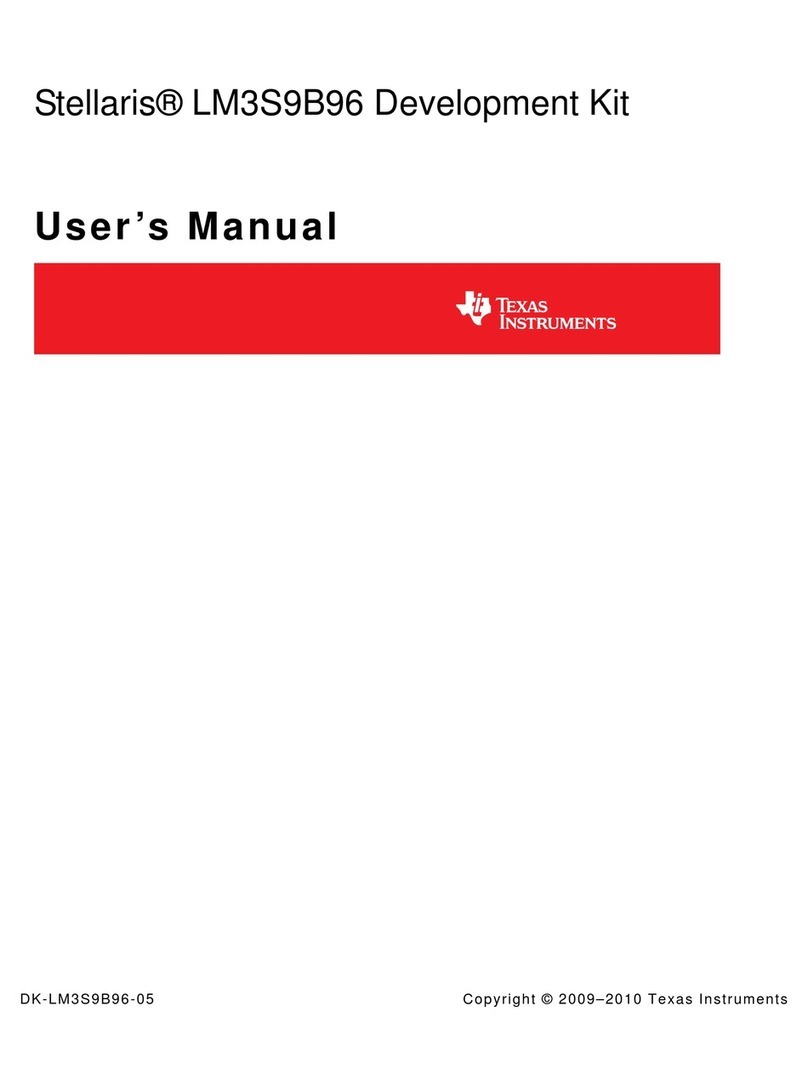
Texas Instruments
Texas Instruments Stellaris LM3S9B96 user manual
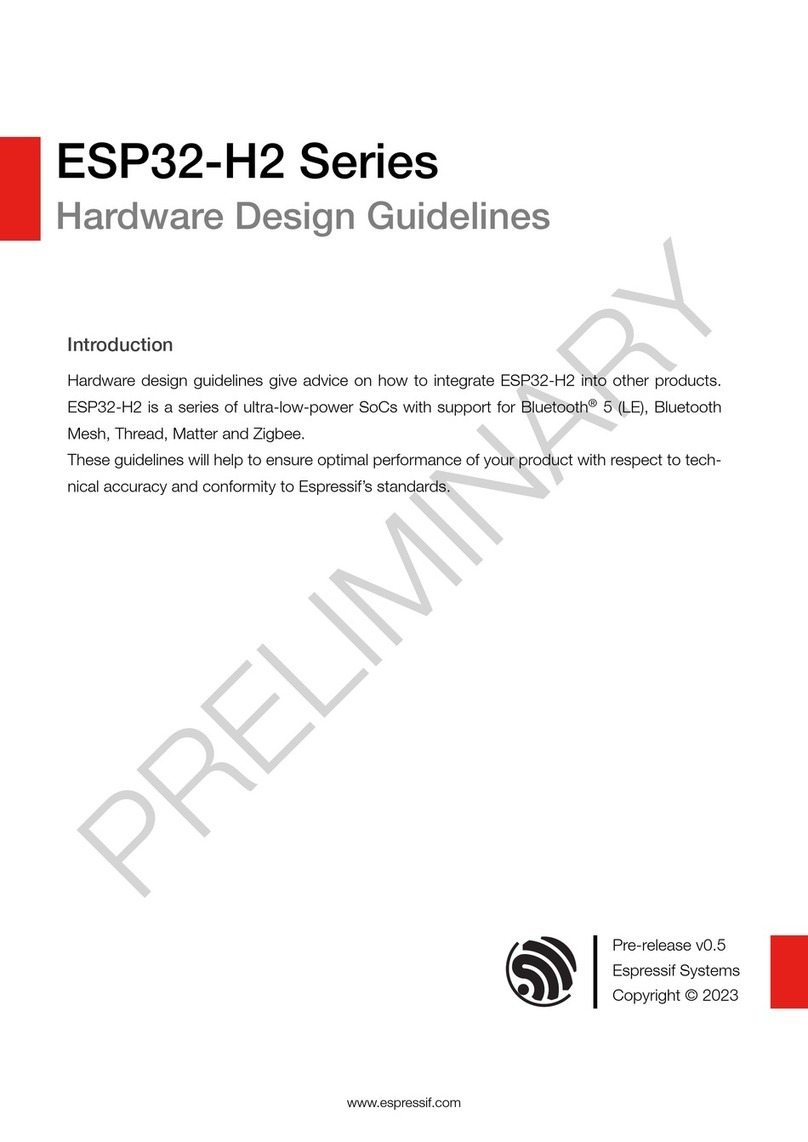
Espressif Systems
Espressif Systems ESP32-H2 Series Hardware Design Guidelines
NXP Semiconductors
NXP Semiconductors LPC11U3x user manual
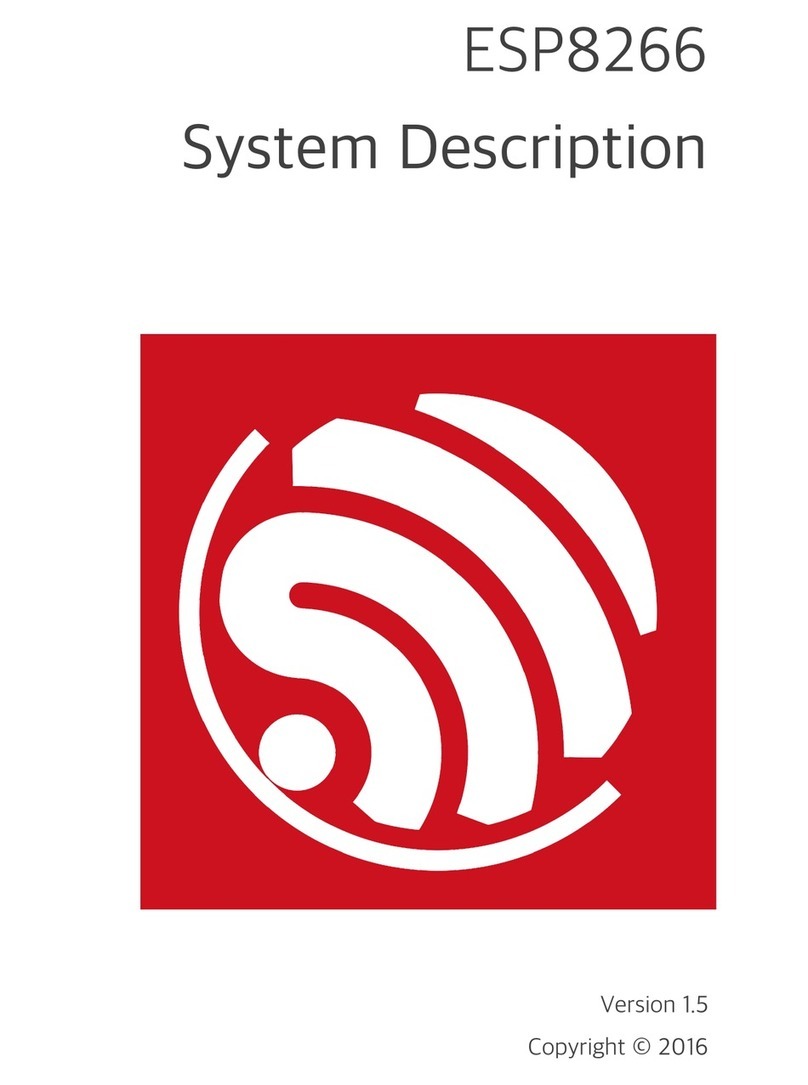
Espressif
Espressif ESP8266 Series System description
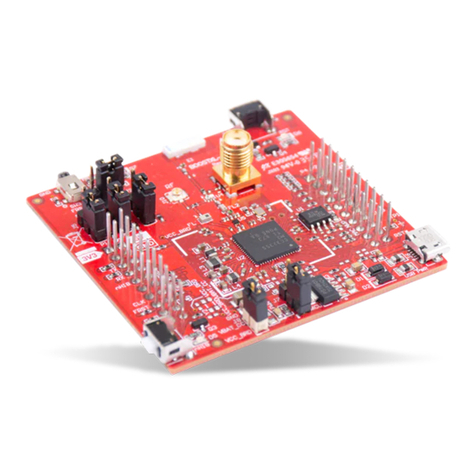
Texas Instruments
Texas Instruments SimpleLink Wi-Fi BoosterPack CC3135 user guide

Cypress
Cypress CYALKIT-E03 Kit Guide
